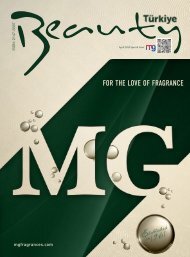SleepTech_January - February 2019
SleepTech_January - February 2019
SleepTech_January - February 2019
You also want an ePaper? Increase the reach of your titles
YUMPU automatically turns print PDFs into web optimized ePapers that Google loves.
60<br />
are in a position to establish<br />
trends internationally.<br />
How Trevira CS works<br />
Comfort and safety, the two most<br />
important requirements in home<br />
textiles were first successfully combined<br />
in 1980: with flame retardant<br />
Trevira fibers and yarns.<br />
Textiles made from these fibers<br />
and yarns bear the trademark<br />
Trevira CS and are permanently<br />
flame retardant. Unlike fabrics<br />
that receive a surface treatment<br />
at a later stage, Trevira CS textiles<br />
offer long-term security.<br />
This small but decisive difference<br />
results from the chemical structure<br />
of the polyester fiber. In the shape<br />
of a comonomer – a phosphor-organic<br />
compound, where the flame<br />
retardant properties are firmly<br />
anchored in the fibre. It is not<br />
possible for external influences to<br />
affect them.<br />
Fibers given an additional flame<br />
protection finish (right) can lose<br />
the protection as a result of wear,<br />
age or frequent washing. Flame<br />
retardant Trevira fibers (left) are<br />
inherently flame retardant. For this<br />
reason materials made from these<br />
fibers and filament yarns are likewise<br />
permanently flame retardant.<br />
This is an important argument<br />
from the ecological aspect as well.<br />
Apart from their environmentally<br />
friendly manufacture materials in<br />
Trevira CS require no additional<br />
fire protection treatment, such as<br />
normally combustible materials<br />
need. Treatments of this kind<br />
are harmful to the environment.<br />
Flame retardant Trevira fibers and<br />
filaments are, furthermore, certified<br />
to Oekotex 100 Standard. In<br />
comparative terms only very slight<br />
amounts of toxic fumes develop in<br />
the event of a fire. This is particularly<br />
important, since in a fire the<br />
danger of suffocation from smoke<br />
fumes is greater than the risk of<br />
injury from flames.

















